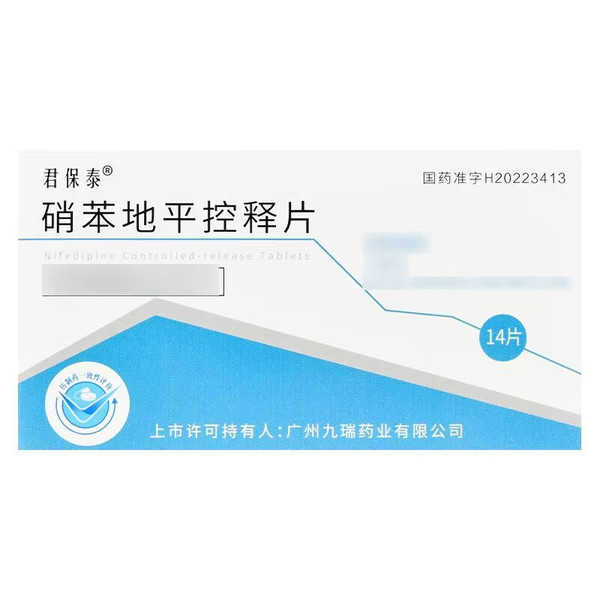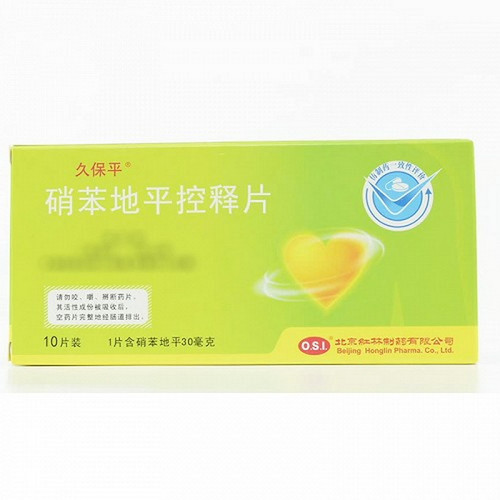Product Overview
[Drug Name]
Generic Name: Nifedipine Controlled-Release Tablets
Trade Name: Junbaotai Nifedipine Controlled-Release Tablets 30mg*14 Tablets
Pinyin Full Code: JunBaoTai XiaoBenDiPingKongShiPian 30mg*14 Tablets
[Main Ingredient]
The main ingredient of this product is nifedipine. Chemical Name: 2,6-Dimethyl-4-(2-nitrophenyl)-1,4-dihydro-3,5-pyridinedicarboxylic acid dimethyl ester. Molecular Formula: C₁ₐH₁₈N₂O₆. Molecular Weight: 346.34
[Properties]
This product is a film-coated tablet. After removing the coating, the tablet core appears to be a double layer consisting of a yellow (drug-containing layer) and a reddish-brown (push layer).
[Indications/Main Functions]
1. Hypertension 2. Coronary Artery Disease: Chronic Stable Angina (Exertional Angina)
[Specifications]
30mg*14 tablets
[Dosage and Administration]
Treatment should be tailored to individual needs whenever possible. A different baseline dose may be administered based on the patient's clinical condition. Unless otherwise directed by a physician, the following dosage is recommended for adults: 1. Hypertension: The recommended dose is 30mg (1 tablet) once daily. If necessary, the dose can be increased to 60mg (2 tablets) once daily based on individual needs. 2. Coronary Artery Disease: Chronic Stable Angina (Exertional Angina) The usual initial dose for treatment is 30mg (1 tablet) once daily. If necessary, the dose can be increased to 60mg (2 tablets) once daily based on individual needs. Nifedipine dosage adjustment or omission may be necessary when used with CYP3A4 inhibitors or inducers (see [Drug Interactions]). Duration of treatment: The duration of treatment should be determined by the physician. Dosage: Generally, swallow the entire tablet with a small amount of liquid, regardless of mealtime. Grapefruit juice should be avoided (see [Drug Interactions]). Special Populations: Patients with mild, moderate, or severe hepatic impairment based on the Child-Pugh score should be carefully monitored and may require a dose reduction. The pharmacokinetics of nifedipine have not been studied in patients with severe hepatic impairment (see [Precautions] and [Pharmacokinetics]).
[Adverse Reactions]
See the package insert for details.
[Contraindications]
· This product is contraindicated in patients with known hypersensitivity to nifedipine or any of its ingredients. · Nifedipine is contraindicated in cardiogenic shock. · Nifedipine is contraindicated in patients with a KOCK pouch (ileostomy after proctocolectomy). · Due to enzyme induction, effective plasma concentrations of nifedipine are not achieved when taken concomitantly with rifampicin. Therefore, it should not be used concomitantly with rifampicin. · Nifedipine is contraindicated in women who are pregnant for 20 weeks or are breastfeeding.
[Precautions]
1. Patients with heart failure and severe aortic stenosis should use this drug with extreme caution when experiencing very low blood pressure (severe hypotension with systolic blood pressure <90 mmHg). 2. This drug contains non-deformable material, so it should be used with caution in patients with severe gastrointestinal stenosis due to the possibility of obstructive symptoms. Gastric stones are very rare, but if they occur, surgery may be required. 3. Case reports have reported cases of obstructive symptoms in patients without gastrointestinal problems. 4. This drug may cause false-positive results during barium meal X-rays (misinterpretation of polyps due to filling defects). 5. Patients with mild, moderate, or severe hepatic impairment based on the Child-Pugh score should be carefully monitored and may require a dose reduction. The pharmacokinetics of nifedipine have not been studied in patients with severe hepatic impairment (see [Dosage and Administration] and [Pharmacokinetics]). Therefore, nifedipine should be used with caution in patients with severe hepatic impairment. 6. Nifedipine is metabolized and eliminated through the cytochrome P450 3A4 system. Therefore, drugs that inhibit or induce the cytochrome P450 3A4 system may alter the first-pass effect or clearance of nifedipine (see [Drug Interactions] for details). Therefore, weak to moderate inhibitors of the cytochrome P450 3A4 system may increase nifedipine plasma concentrations. Examples include: - macrolide antibiotics (e.g., erythromycin); - anti-HIV protease inhibitors (e.g., ritonavir); - azole antifungals (e.g., ketoconazole); - antidepressants: nefazodone and fluoxetine; - quinupristin/dalfopristin; - valproic acid; - cimetidine. When nifedipine is coadministered with these drugs, blood pressure should be monitored and, if necessary, a nifedipine dose reduction should be considered. 7. Effects on Ability to Drive and Use Machines: Responses to medications vary from person to person, and therefore may affect the ability to drive and use machines. This effect is particularly pronounced at the beginning of treatment, when changing medications, and when drinking alcohol. 8. This product has a non-absorbable outer shell, which allows the drug to be slowly released into the body for absorption. When this process is complete, the intact, empty tablet can be found in the feces. 9. Nifedipine controlled-release tablets contain a photosensitive active ingredient and should be stored away from light. The tablets should be kept away from moisture and should be taken immediately after removal from the aluminum-plastic packaging.







